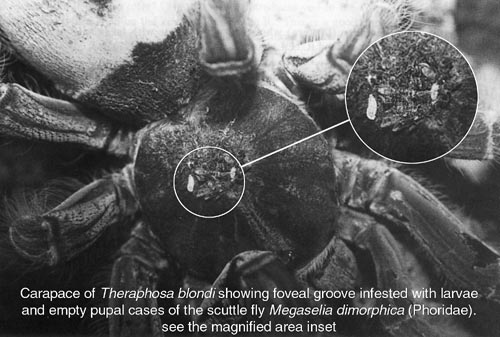|
Scuttle Flies And
Their Relationship With Tarantulas
Guy Tansley
In Vol. 7 No. 1 of the American
Tarantula Society Forum, there appeared an article on scuttle flies (Phoridae) which
associate with large tarantulas from South America. This article became of interest
recently, as I have since acquired a large female Goliath (Theraphosa blondi) and noticed
several small flies gathered on the spiders carapace and abdomen.
The flies (six in total) were reluctant to leave the spider and ran (hence the common
name) rather than flew to evade capture. With the aid of a pooter, all of the flies were
collected, but on closer inspection of the spider I noticed there were several empty pupal
cases surrounding and attached to the foveal region of the carapace.The short, velvet-like
hairs on the carapace also looked as though they had been "grazed" upon.
Despitethis, the spider seemed unaware of the presence of the flies and the pupae, they
being attached to the only part of the spider it couldn't reach when cleaning itself.
As time passed I kept a close eye on the spider and over the following two weeks, a total
of nine fly larvae were collected from it and it's container. These were quite large and
easily visible on the carapace and simply removed with a pair of forceps (a very long
pair!), the spider even allowing me to clear it's foveal groove of empty pupal cases and
larvae.

Two adult flies were preserved in alcohol and sent to Dr. Henry Disney at Dept. Zoology,
University of Cambridge, England and these he identified as one of three recently
discovered and described species whose larvae live on tarantulas. This species was
Megaselia dimorphica which is host-specific to Theraphosa blondi. The other two species,
M. preadafura and M. tinteri being host-specific to Megaphobema robustum and Pamphobeteus
vespertinus respectively.
Observation shows that the larvae and subsequent adult flies feed primarily on the
decaying prey of their host. This became apparent after the spider was fed large
piece of raw meat. The spider spent several hours consuming the meat and fly larvae were
collected on and around the discarded remains and these larvae had taken on a distinctly
red appearance caused by the blood in the meat. One larva was collected from the foveal
groove in the process of pupation, having gorged itself. It can be assumed that the flies
also stay on the spider when they emerge and also feed on prey remains, exuvial fluid,
etc. They also mate and lay eggs on the host, repeating the process all over. It seems the
fly larvae do not actually harm the spider (the worst case would be larvae in the spiders
chitinous skin or stray larvae entering an egg sac during construction). The larvae have
been reported to be able to fast for up to two months, which would relate to the spiders
fluctuating food supply, but well-fed larvae usually pupate within a month. Larvae of
related species are known to possess a pair of sucker-like structures near the mouth and
several rows of hooks on the underside of the rear end. This helps the larvae stay
attached to the short hairs of the spider and, if groomed off, enable them to climb back
easily.
These host-specific Megaselia should not be confused with related species (many Phoridae
species occur in England) which feed on decaying organic material, and the only real
problem is infestation of same-species hosts within a collection. My specimen is now clear
of these intruders and hopefully there will be no sign of them in the future. However, if
you do acquire imported spiders, it's always a good idea to check the thoroughly either
before purchase or immediately afterward. If they're present, keep the spider isolated and
slowly but surely the larvae can be removed.
The fruit fly-like Phoridae sub-order contains some amazing species, all recognisable by
their rapid scuttling gait and humpbacked appearance. Of the British species, some are
know to be parasites on invertebrates; millipedes, beetles and other larger flies. One
species, Pseudoacteon formicarum, has a truly fascinating relationship with ants - the fly
hovers over the ant and even chases it, laying its eggs on the soft exposed parts of the
ants body, attracted initially by the scent of the ants acid.
These flies represent the close relationship between parasite and host, and make clear
what can happen if a certain species becomes threatened in its natural environment. We
tend to concentrate our concerns on the large host species and fail to notice the
intricate interdependence of parasites which have evolved to live on one particular host.
It also highlights the fact that many more connected species of insect are lost when a
host species becomes extinct. In their natural environment these flies may play an
important role in the spider lifestyle, keeping the burrow free from decaying material
resulting in a reduction of mould growth, etc.
Dr. Disney is eager to receive further specimens of scuttle flies, especially flies from
spider species other than those mentioned above. As these are relatively new discoveries
to science, there may be several more types just waiting to be described.
Adult flies, pupae and larvae should be preserved in alcohol and labelled with the
relevant information (name of host, date and collection site if known) and sent to : Dr.
H. Disney, Dept. of Zoology, University of Cambridge, Downing Street, Cambridge, CB2 3EJ,
England.
References
Two new species of Phoridae (Diptera) whose larvae
associate with large spiders (Araneae: Theraphosidae)
D. Weinmann and R. H. L. Disney. J. Zool. Lond. (1977) 243, 319 - 328.
A further new species of Phoridae (Diptera) whose larvae associate with large spiders
(Araneae:
Theraphosidae) R. H. L. Disney and D. Weinmann. Ent. Scand. Vol. 29:1 (1998).
Flies take advantage of tarantulas Samuel D. Marshall and R. H. L. Disney. America
Tarantula Society
Forum Vol. 7 No. 1 : 3 - 4 (1998)
|
